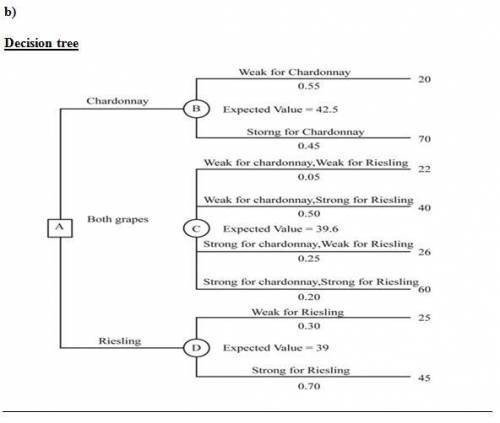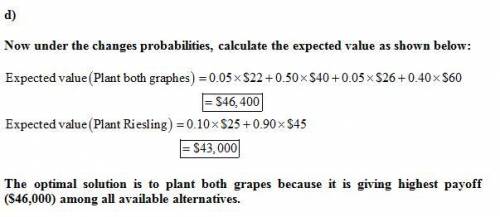
Seneca Hill Winery recently purchased land for the purpose of establishing a new vineyard. Management is considering two varieties of white grapes for the new vineyard: Chardonnay and Riesling. The Chardonnay grapes would be used to produce a dry Chardonnay wine, and the Riesling grapes would be used to produce a semidry Riesling wine. It takes approximately four years from the time of planting before new grapes can be harvested. This length of time creates a great deal of uncertainty about future demand and makes the decision concerning the type of grapes to plant difficult. Three possibilities are being considered: Chardonnay grapes only; Riesling grapes only; and both Chardonnayand Riesling grapes. Seneca management decided that for planning purposes it would be adequate to consider only two demand possibilities for each type of wine: strong or weak. With two possibilities for each type of wine it was necessary to assess four probabilities. With the help of some forecasts in industry publications management made the following probability assessments:
Riesling Demand
Chardonnay Demand Weak S trong
Weak 0.05 0.50
Strong 0.25 0.20
Revenue projections show an annual contribution to profit of $20,000 if Seneca Hill only plants Chardonnay grapes and demand is weak for Chardonnay wine, and $70,000 if they only plant Chardonnay grapes and demand is strong for Chardonnay wine. If they only plant Riesling grapes, the annual profit projection is $25,000 if demand is weak for Riesling grapes and $45,000 if demand is strong for Riesling grapes. If Seneca plants both types of grapes, the annual profit projections are shown in the following table:
Riesling Demand
Chardonnay Demand Weak Strong
Weak $22,000 $40,000
Strong $26,000 $60,000
a. What is the decision to be made, what is the chance event, and what is the consequence? Identify the alternatives for the decisions and the possible outcomes for the chance events.
b. Develop a decision tree.
c. Use the expected value approach to recommend which alternative Seneca Hill Winery should follow in order to maximize expected annual profit.
d. Suppose management is concerned about the probability assessments when demand for Chardonnay wine is strong. Some believe it is likely for Riesling demand to also be strong in this case. Suppose the probability of strong demand for Chardonnay and weak demand for Riesling is 0.05 and that the probability of strong demand for Chardonnay and strong demand for Riesling is 0.40. How does this change the recommended decision? Assume that the probabilities when Chardonnay demand is weak are still 0.05 and 0.50.
e. Other members of the management team expect the Chardonnay market to become saturated at some point in the future, causing a fall in prices. Suppose that the annual profit projections fall to $50,000 when demand for Chardonnay is strong and Chardonnay grapes only are planted. Using the original probability assessments, determine how this change would affect the optimal decision.

Answers: 3
Another question on Business

Business, 21.06.2019 16:30
Calculate the required rate of return for an asset that has a beta of 1.73, given a risk-free rate of 5.3% and a market return of 9.9%. b. if investors have become more risk-averse due to recent geopolitical events, and the market return rises to 12.7%, what is the required rate of return for the same asset?
Answers: 2

Business, 22.06.2019 03:00
Presented below is a list of possible transactions. analyze the effect of the 18 transactions on the financial statement categories indicated. transactions assets liabilities owners’ equity net income 1. purchased inventory for $80,000 on account (assume perpetual system is used). 2. issued an $80,000 note payable in payment on account (see item 1 above). 3. recorded accrued interest on the note from item 2 above. 4. borrowed $100,000 from the bank by signing a 6-month, $112,000, zero-interest-bearing note. 5. recognized 4 months’ interest expense on the note from item 4 above. 6. recorded cash sales of $75,260, which includes 6% sales tax. 7. recorded wage expense of $35,000. the cash paid was $25,000; the difference was due to various amounts withheld. 8. recorded employer’s payroll taxes. 9. accrued accumulated vacation pay. 10. recorded an asset retirement obligation. 11. recorded bonuses due to employees. 12. recorded a contingent loss on a lawsuit that the company will probably lose. 13. accrued warranty expense (assume expense warranty approach). 14. paid warranty costs that were accrued in item 13 above. 15. recorded sales of product and related service-type warranties. 16. paid warranty costs under contracts from item 15 above. 17. recognized warranty revenue (see item 15 above). 18. recorded estimated liability for premium claims outstanding.
Answers: 1

Business, 22.06.2019 23:50
Sabrina gupta, an investment advisor with a major brokerage firm, was examining wal-mart stores, inc. (wal-mart) stock and its valuation. gupta wondered whether to recommend the stock to any of her new clients or to existing clients who did not currently have wal-mart in their portfolios.her key task was to use an intrinsic value approach to price the shares and to then compare the resulting price with the price at which the stock was traded in the market. gupta wanted to use alternative valuation methods and assumptions to produce intrinsic value estimates for wal-mart stock.she was interested in seeing if the alternative methods would point to a consensus regarding the valuation of the stock and to see if the valuations suggested an investment opportunity given the current market price. methods she contemplated to use were: multi-stage growth modelprice earnings multiplemost valuation methods gupta considered required a common set of inputs: future cash flows to wal-mart investorsgrowth rate of future cash flowsdiscount factor or required rate of return by wal-mart investorsgupta gathered data to determine each of the above.gupta thought that dividends to wal-mart shareholders would adequately capture the cash flows to wal-mart shareholders; she also thought that this approach would simplify her task and she would revisit more complex valuation models if she felt the need.gupta thought that capm would provide her a relatively reliable estimate of the required rate of return. capm based required rate of return can be estimated by using a risk free rate, systematic risk of the firm and equity market risk premium. gupta thought that in a valuation exercise that involve long term cash flows, 10-year government bond yield would be an appropriate risk free rate of return estimate. she checked the 10 year note rate and found out that it was about 3.68%. gupta searched for wal-mart beta in bloomberg. bloomberg estimates betas by regressing the s& p 500 returns on the firm returns over the past two years and arrives at a “raw” beta estimate. bloomberg makes an adjustment in raw beta based on some academic research. gupta is confident that bloomberg adjustment is justified and she uses wal-mart beta estimate of 0.66 in her analysis.while gupta is aware of the importance of emrp assumption, she thinks that bloomberg’s historical estimate of 5.05% is a safe assumption. she is aware of the fact that some studies suggest a larger risk premium of approximately six per cent, while others suggest a much lower forward-looking premium of less than four per cent. she is mindful of the arbitrariness of her assumption, and she takes a note to revisit this issue if her valuations produce unreasonable estimates.anticipated dividend growth (g) is often estimated in a variety of ways.first, observed historical dividend growth can be assumed to continue in a perpetual fashion.second, future dividend growth can be estimated on the basis of recent estimates of analysts.gupta noted that the consensus annual wal-mart dividend for fiscal year 2011 was $1.21, and one respected analyst had estimated the expected constant dividend growth (in perpetuity) at approximately 3%.as the chart suggests, both earnings and dividend growth rates are declining but they seem to be higher than the “respected analyst’s” estimates. gupta decides to use several alternative perpetual growth assumptions to see the impact on price. since gupta decided to use variants of dividend discount model (ddm), she checked the anticipated earnings for 2011. analyst’s estimates suggested $4.10 earnings per share. gupta decided to use 10% growth rate from 2011 to 2012 and assumed a steady decline to 3% in 13 years (until 2024) where the perpetual growth rate of 3% resumes. she also assumed that walmart will increase its dividend payout ratio from 30% to 55% from years 2012 to 2024. you are asked to reproduce gupta’s analysis of multi-stage growth model and double check her valuation by using an earnings multiple. you have all the data you need to conduct the multi stage discounted growth model analysis, but you will need to do some research about the multiples valuation.
Answers: 3

Business, 23.06.2019 02:00
When watching the video example 87: function notation, the presenter states that we need to, "go to this function and in the place of x, we will put in " â4 â3 â2 â1?
Answers: 3
You know the right answer?
Seneca Hill Winery recently purchased land for the purpose of establishing a new vineyard. Managemen...
Questions

Biology, 24.03.2021 23:20





Mathematics, 24.03.2021 23:30


English, 24.03.2021 23:30





Business, 24.03.2021 23:30

Mathematics, 24.03.2021 23:30

Chemistry, 24.03.2021 23:30


English, 24.03.2021 23:30

French, 24.03.2021 23:30

Health, 24.03.2021 23:30

Mathematics, 24.03.2021 23:30






